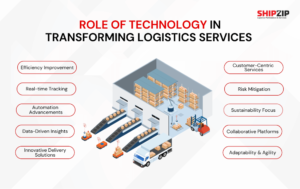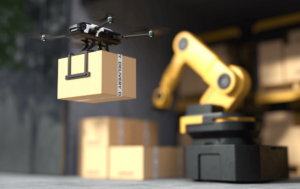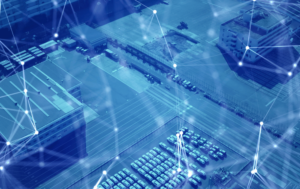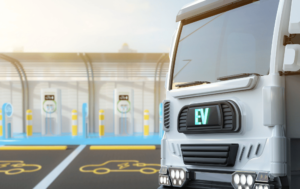
1.12.23
In today’s fast-paced world, getting things from A to B is no longer just about trucks & warehouses. It’s also about how technology is revolutionizing logistics services.
Technology has taken the wheel, steering the logistics industry into a new era. Nearly 15% of all logistics costs can be saved through better technology use. That’s where the game changes. From warehouse automation to route optimization software, technological innovations have revolutionized the way goods are transported, distributed, and tracked.
Yet, here’s the hitch: about 60% of businesses struggle to integrate new tech due to high costs. With the increasing demand for same-day and next-day delivery, companies have had to adapt by implementing sophisticated logistics strategies and leveraging technology to optimize routes & ensure timely delivery. This has not only improved the customer experience but has also presented new opportunities for businesses to expand their reach.
In this comprehensive analysis, we delve into the key ways that technology is reshaping the logistics industry and the implications for businesses and consumers.

Logistics technology facilitates the efficient movement of goods from production to consumers. It encompasses machinery, vehicles, and computing software, optimizing processes for timely deliveries worldwide.
The industry’s complexity drives ongoing technological advancements to meet demands for quicker shipping, remote deliveries, and handling larger cargo. Successful companies prioritize tech investments for streamlined operations and swift problem-solving, crucial for remaining competitive.
Innovative logistics tech redefines shipping by digitizing operations. Traditional manual processes are giving way to digital transformations, driving the industry forward.

Transforming Tracking: GPS technology has turned logistics into a high-precision affair. Gone are the days of uncertainty in tracking shipments. Now, real-time GPS tracking ensures that businesses and customers can track their shipments with pinpoint accuracy.
Efficiency and Route Optimization: With GPS, companies can dynamically optimize routes. This means analyzing traffic patterns and road conditions in real-time to avoid delays, which not only saves time but also reduces fuel consumption and costs.
Enhanced Customer Trust: For customers, GPS tracking is a game-changer. It builds trust and satisfaction as they can see their orders moving in real-time, from the warehouse right to their doorstep.
Delhivery, a logistics giant in India, maximizes operational efficiency and customer delight through GPS-driven route optimization. Simultaneously, Rivigo’s inventive use of GPS in its relay model not only ensures timely deliveries but also sets a new industry standard for efficiency and driver welfare.

Robotics in Inventory Management: The introduction of robots in warehouses is revolutionizing inventory management. These advanced machines, equipped with AI and sensors, streamline processes like picking, packing, and transporting goods, dramatically reducing human error and increasing efficiency.
Enhanced Productivity and Accuracy: Robots in warehouses are not just about replacing human labour; they complement it by handling repetitive or dangerous tasks, allowing human workers to focus on more complex tasks. This collaboration leads to higher productivity and accuracy in warehouse operations.
Drones in Logistics: The use of automated guided vehicles (AGVs) and drones for transportation has the potential to further optimize logistics operations. It can navigate challenging terrains and deliver goods to remote locations, offering a new level of convenience and speed.
Regulatory and Practical Challenges: While drone deliveries are promising, they face regulatory hurdles and practical challenges in India. Issues like air traffic control, safety standards, and privacy concerns need to be addressed before drones can become a mainstream delivery method.
Amazon’s adoption of robots for sorting and picking has transformed warehouse operations, slashing processing times and boosting efficiency. Meanwhile, companies like GreyOrange and Geek+ pioneering Automated Guided Vehicles (AGVs) in India showcase substantial cost and time savings, revolutionizing warehouse practices.

By harnessing the power of data, companies can gain valuable insights into their supply chain operations, identify trends, and make data-driven decisions.
Unraveling Complex Patterns: Big Data in logistics involves analyzing vast amounts of data to uncover hidden patterns, trends, and insights. This deep analysis leads to more informed decision-making and strategy formulation in logistics.
Predictive Insights for Demand and Supply: By leveraging Big Data, companies can predict demand surges, manage inventory more effectively, and optimize supply chains. This foresight reduces waste and ensures resources are allocated efficiently.
AI-Driven Forecasting: Artificial Intelligence (AI) in logistics is reshaping how companies forecast demand and manage supply chains. AI algorithms can analyze market trends, consumer behaviour, and other variables to predict future demand with remarkable accuracy.
Real-Time Adjustments and Efficiency: AI enables logistics companies to make real-time adjustments to their operations, ensuring they are always ahead of the curve. This responsiveness leads to improved efficiency and customer satisfaction.
DHL’s Resilience360 tool harnesses big data and analytics for comprehensive supply chain visibility, aiding businesses in anticipating, responding to, and recovering from disruptions.
In India, companies like Swiggy and Zomato utilize AI to streamline last-mile delivery routes amidst dense urban traffic, slashing delivery times and elevating customer satisfaction.

The Internet of Things (IoT) has enabled the integration of physical devices and sensors with the Internet, creating a network of interconnected devices.
Interconnected Logistics: The Internet of Things (IoT) is creating a network where vehicles, warehouses, and goods are all connected and communicating. This interconnectivity allows for seamless coordination across different stages of the logistics chain.
Enhanced Visibility and Control: IoT devices provide real-time data on vehicle locations, cargo conditions, and warehouse inventories. This information empowers companies to make more informed decisions, leading to improved operational control and efficiency.
Global shipping leader Maersk uses IoT to track containers, offering customers real-time data on the location and condition of their goods, significantly enhancing transparency in international shipping.
Indian logistics companies are integrating IoT in fleet management to optimize routes, monitor vehicle health, and enhance driver safety, leading to more efficient and sustainable operations.

It has gained significant attention in recent years due to its potential to improve transparency, security, and traceability in various industries, including logistics.
Immutable Records: Blockchain technology offers a secure and transparent way to record transactions and track assets in the logistics chain. This ensures data integrity and builds trust among all parties involved.
Streamlined Processes: By utilizing blockchain, logistics companies can streamline their operations, reduce paperwork, and eliminate inefficiencies caused by traditional record-keeping methods.
Walmart’s Blockchain for Food Safety: Walmart has implemented a blockchain system for end-to-end traceability in its food supply chain, enhancing transparency and response time to food safety issues.

Reducing Carbon Footprint: Advanced technologies like electric vehicles and AI-based route optimization are helping to reduce the carbon footprint of logistics operations.
Eco-friendly Packaging: Innovations in packaging, such as biodegradable materials, contribute significantly to environmental sustainability.
LogiNext, a prominent logistics tech firm, is implementing green solutions in its delivery operations, such as using electric vehicles attachment for last-mile delivery.
EcoEnclose is pioneering eco-friendly packaging solutions in India, offering a range of sustainable packaging options to businesses.
🔻Challenges:
Strategic planning and careful management of these challenges can help maximize the benefits of logistics technology adoption while minimizing potential disruptions.
The logistics industry’s future, shaped by how technology is revolutionizing logistics services, is promising. Advancements in technology will continue to drive innovation and reshape the way goods are transported, stored, and delivered. With the ongoing development of autonomous vehicles, drones, and robotics, logistics operations will become more efficient, cost-effective, and environmentally friendly.
Furthermore, integrating AI, big data analytics, and blockchain technology will enable companies to make data-driven decisions, improve transparency, and enhance overall supply chain visibility.
We at ShipZip, a logistics company in Kolkata are committed to leveraging these technological advancements to provide top-notch, innovative logistics solutions.